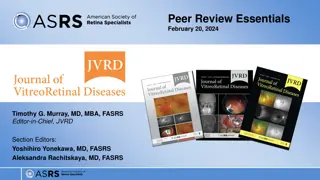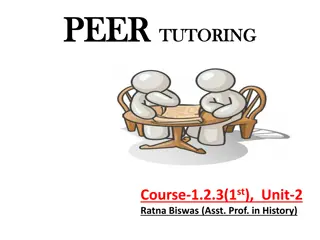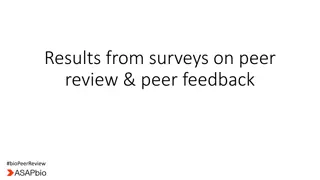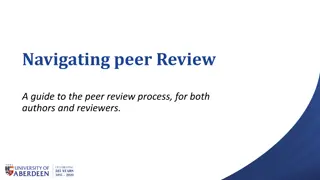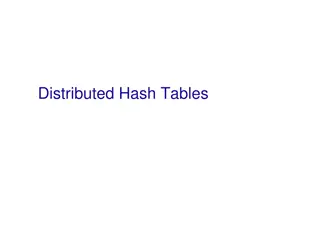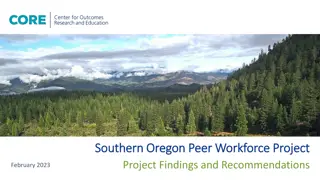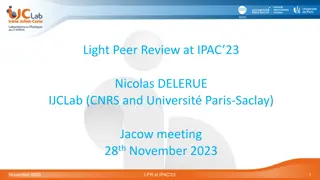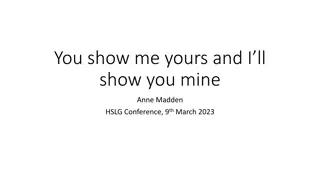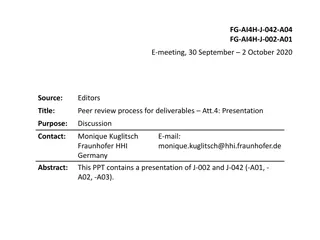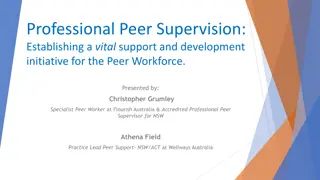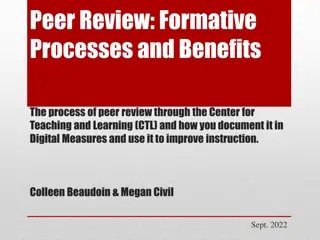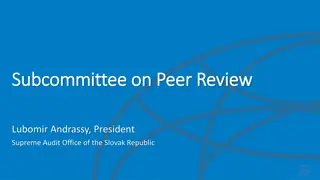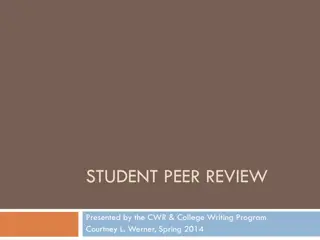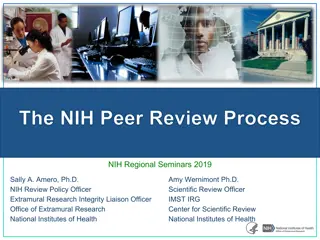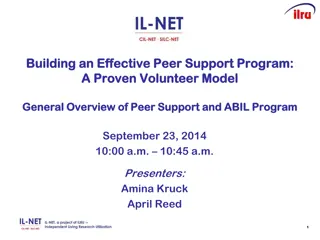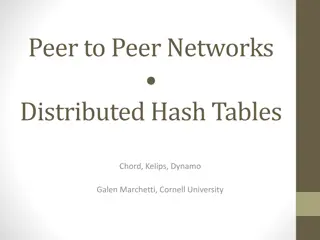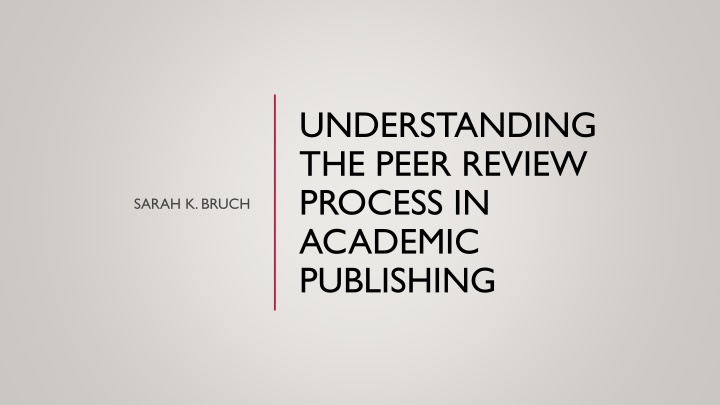
Understanding Peer Review Process in Academic Publishing
Explore the basics of peer review in academic publishing, including its importance, when it is used, and how to write a peer review. Discover the steps involved in selecting the right journal for publication and understand why peer review is crucial for academic knowledge generation and quality assurance.
Download Presentation

Please find below an Image/Link to download the presentation.
The content on the website is provided AS IS for your information and personal use only. It may not be sold, licensed, or shared on other websites without obtaining consent from the author. If you encounter any issues during the download, it is possible that the publisher has removed the file from their server.
You are allowed to download the files provided on this website for personal or commercial use, subject to the condition that they are used lawfully. All files are the property of their respective owners.
The content on the website is provided AS IS for your information and personal use only. It may not be sold, licensed, or shared on other websites without obtaining consent from the author.
E N D
Presentation Transcript
UNDERSTANDING THE PEER REVIEW PROCESS IN ACADEMIC PUBLISHING SARAH K. BRUCH
AGENDA PEER REVIEW BASICS WHAT TO EXPECT & HOW TO RESPOND HOW TO WRITE A PEER REVIEW Q & A
PEER REVIEW: THE BASICS What is Peer Review? Review process for assessing the validity, significance and originality of research Peers are experts in a given field of study When is Peer Review Used? publications (articles and books) funding (fellowships and grants) conferences (panel presentations and posters) promotion and tenure
PEER REVIEW: THE BASICS Why is Peer Review Important? facilitates academic knowledge generation serves to legitimate knowledge (epistemic and social legitimacy) signals quality (self-regulation of the knowledge community) Provides perspective on the work Debates/Controversies bias and subjectivity in editorial and reviewer assessments limited accountability and justification for decision-making replicability and transparency gatekeeping mistakes
PEER REVIEW: THE BASICS Source: Standing up for Science: Peer review, the nuts and bolts: A guide for early career researchers.
STEP 1: WHICH JOURNAL? Audiences and Purposes How to: generalist vs specialist look at your own reference list discipline-specific vs interdisciplinary field look at journal homepage to identify aim and scope sub-field/sub-disciplinary specialty journals that have specific topic/area focus look at TOC to identify the kinds of things they publish methodological approach look at introductions of articles to identify how research is framed (i.e. sociologists have long studied a key question animating sociology of education is ) format or type of research (ex. review, original research, theoretical ideas) access
STEP 1: WHICH JOURNAL? Rankings, Prestige, and Quality How to: journals vary in quality and prestige ask scholars in the field consider the quality of the contribution you think the piece is making look at impact factors, citation reports, altmetrics, etc.
STEP 1: WHICH JOURNAL? Resources: ASPA Listing of Journals (link) APSA Listing of Journals (link) ASA Publishing Options Searchable Database (ASA member log in required) U of Michigan Libraries. Guide on judging the reputation of a journal (link) Suiter, Amy M. and Cathy C. Sarli 2019 Selecting a Journal for Publication: Criteria to Consider
STEP 2: PREPARE SUBMISSION Submission Guides or Instructions for Authors All journals have specific guidelines for every aspect of the paper submission Word count, page count, table/figure limits Page and reference formatting Sometimes these can also be a partial selection criteria for your work Resources: Tips on Submitting Papers for Review by outgoing editors and professional associations: MacDonald et al. 2006 (link); AJE (link) EEPA (link); ASLO (link)
WHAT TO EXPECT - PEER REVIEW Typical format double-blind or single-blind (impartiality) editorial board with 1-2 editors and set of secondary editors send to 2-4 reviewers (looking for level of agreement among reviewers) editors and associate editors make final decision and send decision letter (sometimes with substantive assessment of what the editor thinks are the main issues that need to be addressed but sometimes not just the reviewer letters)
WHAT TO EXPECT - PEER REVIEW Rejection Most top journals in fields have acceptance rates that are less than 10%! A lot of submissions are desk rejected by the editor (editor decision based largely on fit with journal aim or scope) Majority of articles sent out for review are rejected Sources: Sanscartier, Matthew and Matthew Johnston. 2018 How to thrive on academic criticism (link) Garand and Harman 2021. Journal Desk-Rejection Practices in Political Science: Bringing Data to Bear on What Journals Do PS: Political Science & Politics 54(4): 676-681.
WHAT TO EXPECT - PEER REVIEW Journal Responses: Rejection Invitation to Revise & Resubmit (R&R) different types Conditional acceptance (or Accept with minor revisions) Acceptance Time to Initial Decision & Entire Review Process Initial decision typically 2-4 months or more (varies by field and journal) Time from initial submission to publication takes several months or more Resources: American Sociological Association Journal Annual Reports (which includes acceptance rates) (link); American Psychological Association Journal Summary Statistics (link)
WHAT TO EXPECT - PEER REVIEW Invitations to Revise and Resubmit (R&R) Read over the entire letter from the Editor and all the reviews Use reviewers comments to help you identify and solve problems with your research and writing Try your best to separate substantive content from tone Always take the Editor s guidance most seriously Also be sure to notice any positive comments from either the Editor or the reviewers Resources: Sovacool et al. 2022 Towards codes of practice for navigating the academic peer review process
WHAT TO EXPECT - PEER REVIEW Revision Memo Address all reviewer comments and concerns. Provide rationale for why you made each particular research choice relative to the alternative(s)
WHAT TO EXPECT - PEER REVIEW Revision Memo Address all reviewer comments and concerns. Provide rationale for why you made each particular research choice relative to the alternative(s)
WHAT TO EXPECT - PEER REVIEW Revision Memo Address all reviewer comments and concerns. Provide rationale for why you made each particular research choice relative to the alternative(s)
WRITING A PEER REVIEW When accepting the invitation to review you are: agreeing to provide a fair, robust and timely assessment that is useful for the authors in improving their manuscript asserting that you do not have a conflict of interest (i.e. you would be advantaged in some way; work at same institution; are a close colleague; been a mentor or advisor in the past several years; etc.)
WRITING A PEER REVIEW Source: Standing up for Science: Peer review, the nuts and bolts: A guide for early career researchers.
CRITERIA OF USEFUL PEER REVIEWS The most useful reviews are: Critical: assessment of both the strengths and weaknesses of the research Constructive: describe particular concerns that you identify, explain why they matter, and offer constructive suggestions for strengthening the research Resources: JPAM Guide for Reviewers (link); PLOS How to Write a Review (link); Cambridge Guide to Peer Reviewing Journal Articles (link); Wiley Peer Review Guidelines (link); Sovacool et al. 2022 Towards codes of practice for navigating the academic peer review process
RESOURCES Slide decks for previous sessions CV and Academic Bio Workshop Presenting and Talking about Your Work Preparing for Research Careers Funding, Research, & Training Opportunities Preparing for the Academic Job Market Preparing for Academic Presentations Related Readings Van Cott, D. L. 2005. A Graduate Student s Guide to Publishing Scholarly Journal Articles. PS: Political Science and Politics 38 (4): 741 743. Pirog, Maureen. 2014. The Art and Science of Scholarly Publishing. JPAM 33(3): 843-853. Blair et al. 2020. Publishing in political science journals European Political Science 19:641 652. Available on Biden School website at: https://www.bidenschool.udel.edu/student-resources

